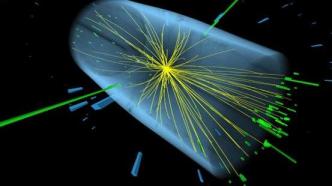

The Higgs boson decays into two photons.
The International Collaboration Group of the Large Hadron Collider (LHC) Compact Muon Coils (CMS) wrote in the latest issue of the journal Nature Physics that their analysis of the mass distribution of the Higgs boson - "width" Made the most accurate measurement to date: 3.2 MeV. This is in line with Standard Model predictions, but more precise than previous measurements, which only indicated that its width must be less than 9.2 MeV.
In the Standard Model of particle physics, the Higgs boson gives mass to all other elementary particles, and was first discovered by the LHC in 2012. But the properties of the Higgs boson are difficult to determine because it decays quickly into other particles and doesn't always appear with the same mass.
Greg Landsberg, a member of the CMS, explained that the latter is a result of Heisenberg's uncertainty principle. The principle states that any particle that exists for a finite time must have a range of possible energies and masses -- widths, not fixed values. In almost all experiments, particles with very small widths have the same mass, while particles with larger widths have very inconsistent masses, and physicists have so far only made inaccurate estimates of the width of the Higgs boson.
In the latest study, the CMS collaboration determined the width of the Higgs boson based on data collected during the second run of the LHC from 2016 to 2018. Their strategy was to compare data on two different processes in which the Higgs boson decays into two other particles. In one process, an unusually massive Higgs boson decays into two Z bosons. In another case, the mass of the Higgs boson is the more common mass predicted by theoretical models. By comparison, the researchers calculated that the Higgs boson could be 3.2 megaelectronvolts wide.
Accurately measuring the width of the Higgs boson could reveal discrepancies in theoretical predictions that could reveal new physical phenomena, such as the Higgs boson that interacts with some exotic dark matter particles, the researchers said. The CMS team hopes to obtain data from the third run of the collider in 2026 to improve its calculations and reveal the "true face of Mount Lu" of the Higgs boson more deeply.
(Original title "Higgs Boson Mass Distribution Obtained the Most Accurate Measurement to Date")
